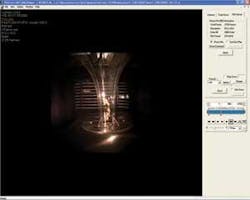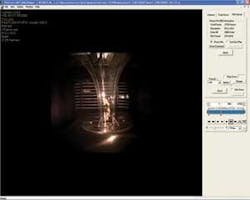Imaging optimizes bagging efficiency
To increase the productivity of the food-packaging industry, high-throughput weighing machines rapidly dispense the correct amount of products into bags before sealing. To do this, companies such as the Dataweigh Division of Yamato (Mequon, WI, USA; www.yamato-scale.co.jp) manufacture multiple-head radial weighing machines that can, for example, fill 60-g potato-chip bags at speeds up to 210 bags per minute.
In operation, bulk product is fed to multiple heads on the weighing machine that each consist of a feed bucket, a dual-chambered weighing bucket, and a dual-chambered memory bucket. As bulk product passes through each weighing bucket it is weighed using computer-controlled load cells. The target weight is then computed against the values of weights in the weigh buckets. If the target weight can be produced, a charge is then dispensed. If a weigh bucket is not used in that cycle, the weigh bucket is then discharged into the memory bucket if empty. Since a known amount of product is held in each weigh bucket and memory bucket, the total weight of the product to be bagged can be computed by dispensing a combination of multiple weigh and/or multiple memory buckets into the bottom gate of the weighing machine.
“By holding a dose of products once in the bottom gate and affording enough time for settling before releasing the product into bags,” says Leonard Bultynck, service coordinator at Yamato, “this ‘bottom-based handling’ allows each bulk product discharge to be separated by a specific time interval.” This is very important since the discharge of each product (or charge) must be precisely synchronized with bagging machinery.
“Here,” says Bultynck, “the minimum separation between charges is approximately 100 ms, and weighing machines, such as Yamato’s Sigma F1 series, must be finely adjusted to achieve this time period. Obtaining this throughput mandated the use of high-speed imaging to analyze the flow of products as they emerged from the weighing machine.”
To capture images of product as they are dispensed, Bultynck deployed the Fastcam-X 512 PCI-based high-speed imaging system from Photron (San Diego, CA, USA; www.photron.com). Consisting of a 10-bit monochrome (30-bit color) CMOS sensor interfaced to a PCI-based add-in card, Photron’s PC-based system can operate at full 512 × 512-pixel resolution as fast as 2000 frames/s, or, with reduced resolution to 32,000 frames/s.
“With an electronic global shutter, we use the Fastcam-X base memory configuration to monitor and store up to 7 s of images of product flow from the Sigma F1 at 512 × 512-pixel resolution,” says Bultynck. This is fast enough to capture an image sequence that consists of two sequential bulk discharges. To measure the period between discharges, Yamato uses Photron Motion Tools for automatic product tracking. By selecting the point of interest within the recorded image sequence, Motion Tools automatically tracks the points of motion within the sequence.
When tracking is complete, all the acquired data can be transferred to a spreadsheet such as Excel for further analysis. Simultaneously, the time sequence can be visualized on the PCs screen, and the time and distance of charges can be measured with an accuracy of approximately 5 ms. Armed with this data, the length of the charge can be measured and the distance between charges.
“This length of charge,” says Bultynck, “may be different for each product and directly relates to the time required to bag dispensed product. By using tools such as Photron’s Fastcam-X, the time between dispensing and bagging can be optimized to increase throughput of packing machinery. In twin-tube applications where the Sigma F1 is configured as an eight-head machine running with two different products and two different target weights, this is especially important,” he concludes.

